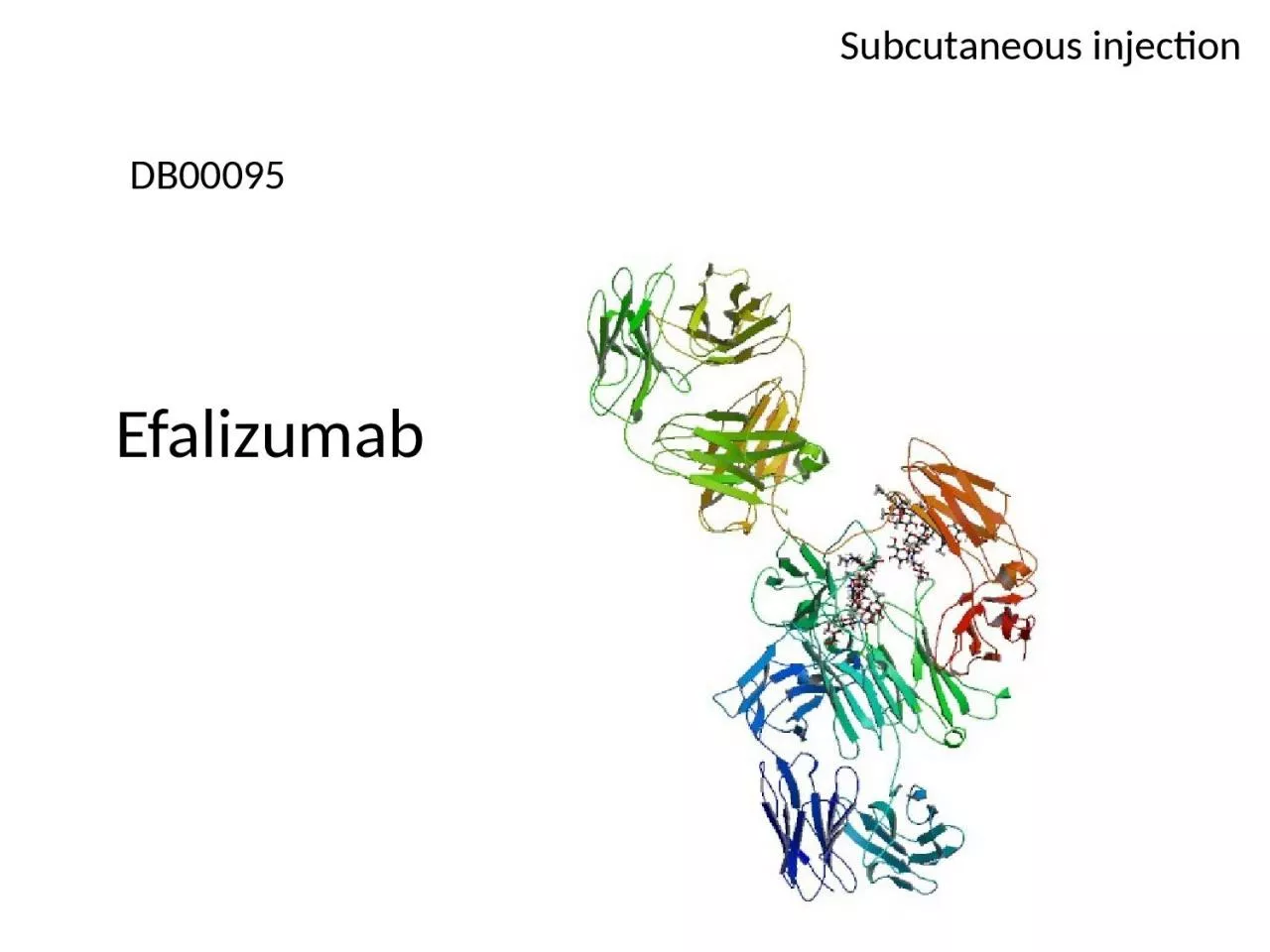

DB00095 DESCRIPTION Humanized IgG1 kappa isotype monoclonal antibody that binds to human CD11a Efalizumab has a molecular weight of approximately 150 kilodaltons and is produced in a Chinese hamster ovary mammalian cell expression system in a nutrient medium containing the antibiotic g ID: 930372
Download Presentation The PPT/PDF document "Efalizumab Subcutaneous injection" is the property of its rightful owner. Permission is granted to download and print the materials on this web site for personal, non-commercial use only, and to display it on your personal computer provided you do not modify the materials and that you retain all copyright notices contained in the materials. By downloading content from our website, you accept the terms of this agreement.
Slide1
Efalizumab
Subcutaneous injection
DB00095
Slide2DESCRIPTION:
Humanized IgG1 kappa isotype monoclonal antibody that binds to human CD11a. Efalizumab has a molecular weight of approximately 150
kilodaltons and is produced in a Chinese hamster ovary mammalian cell expression system in a nutrient medium containing the antibiotic gentamicin.
INDICATIONS:
For
the treatment of adult patients with moderate to severe chronic plaque psoriasis, who are candidates for phototherapy or systemic therapy.
Slide3PHARMACODYNAMICS:Lymphocyte
activation and trafficking to skin play a role in the pathophysiology of chronic plaque psoriasis. In psoriatic skin, ICAM-1 cell surface expression is upregulated on endothelium and keratinocytes. Raptiva inhibits the binding of LFA-1 to the intercellular adhesion molecule-1 (ICAM-1), thereby inhibiting the adhesion of leukocytes to other cell types.
MECHANISM OF ACTION:
Efalizumab
binds to CD11a, a subunit of leukocyte function antigen-1 (LFA-1), which is expressed on all leukocytes. As a result
efalizumab
decreases cell surface expression of CD11a.
ABSORPTION:Average efalizumab bioavailability following subcutaneous administration was estimated at 30 to 50%.
HALF-LIFE: 5
days
Slide4RAPTIVA(Genentech
Inc.)
Humanized IgG1 kappa isotype monoclonal antibody that binds to human CD11a. Efalizumab
has a molecular weight of approximately 150
kilodaltons
and is produced in a Chinese hamster ovary mammalian cell expression system in a nutrient medium containing the antibiotic gentamicin.
Immunosuppressive recombinant humanized IgG1 kappa isotype monoclonal antibody that binds to human CD11a.
Efalizumab
has a molecular weight of approximately 150 kilodaltons and is produced in a Chinese hamster ovary (CHO) mammalian cell expression system
in a nutrient medium containing the antibiotic gentamicin. Gentamicin is not detectable in the final product.
DESCRIPTION
Slide5VIAL DESCRIPTION:
supplied as a sterile, white to off-white, lyophilized powder in single-use glass vials for subcutaneous (SC) injection. Reconstitution of the single-use vial with 1.3 mL of the supplied sterile water for injection (non-USP) yields approximately 1.5 mL of solution to deliver 125 mg per 1.25 mL (100 mg/mL) of RAPTIVA (
efalizumab) . The sterile water for injection supplied does not comply with USP requirement for
pH.
After reconstitution, RAPTIVA (
efalizumab
) is a clear to pale yellow solution with a pH of approximately 6.2. Each single-use vial of RAPTIVA contains 150 mg of
efalizumab, 123.2 mg of sucrose, 6.8 mg of L-histidine hydrochloride monohydrate, 4.3 mg of L-histidine and 3 mg of
polysorbate 20 and is designed to deliver 125 mg of efalizumab in 1.25 mL
Slide6Raptiva (Dosage):
Doses up to 4 mg/kg/wk SC for 10 weeks following a conditioning (0.7 mg/kg) first dose have been administered without an observed increase in acute toxicity. The maximum administered single dose was 10 mg/kg IV. This was administered to one patient, who subsequently was admitted to the hospital for severe vomiting. In case of overdose, it is recommended that the patient be monitored for 24-48 hours for any acute signs or symptoms of adverse reactions or effects and appropriate treatment instituted.
HALF-LIFE: 5 days
Slide7Sequence
>Heavy Chain Variable Region EVQLVESGGGLVQPGGSLRLSCAASGYSFTGHWMNWVRQAPGKGLEWVGIMIHPSDSETRYNQKFKDIRFTISVDKSKNTLYLQMNSLRAEDTAVYYCARIGIYFYGTTYFDYIWGQGTLVTVSS>Light Chain Variable Region DIQMTQSPSSLSASVGDRVTITCRASKTISKYLAWXQQKPGKAPKLLIYSGSTLQSGVPSRFSGSGSGTDFTLTISSLQPEDFATYYCQQHNEYPLTFGQGTKVEIKR
Slide8Mean time to eliminate RAPTIVA (
efalizumab) after the last steady-state dose was 25 days (range = 13-35 days, n = 17)24 mL/kg/day (range = 5-76 mL/kg/day, n = 25)
ADVERSE REACTION:
R
isk of progressive multifocal leukoencephalopathy (PML), Infections, including serious infections leading to hospitalizations or death, have been observed in patients treated with RAPTIVA
Slide9Drug Interaction
Ergonovine: The antiretroviral agent may increase the ergot derivative
Rilonacept: results in increased immunosuppressive effects; increases the risk of infection.
Trastuzumab
:
Trastuzumab
may increase the risk of neutropenia and anemia. Monitor closely for signs and symptoms of adverse events.
Slide10Frampton JE, Plosker
GL: Efalizumab: a review of its use in the management of chronic moderate-to-severe plaque psoriasis. Am J Clin
Dermatol. 2009;10(1):51-72. Pubmed
Descamps
V: [
Efalizumab
] Ann
Dermatol Venereol. 2006 Aug-Sep;133(8-9 Pt 1):666-78.
PubmedChen X, Ji ZL, Chen YZ: TTD: Therapeutic Target Database. Nucleic Acids Res. 2002 Jan 1;30(1):412-5. PubmedOverington
JP, Al-
Lazikani
B, Hopkins AL: How many drug targets are there? Nat Rev Drug
Discov
. 2006 Dec;5(12):993-6.
Pubmed
Imming
P, Sinning C, Meyer A: Drugs, their targets and the nature and number of drug targets. Nat Rev Drug
Discov
. 2006 Oct;5(10):821-34.
Pubmed
References